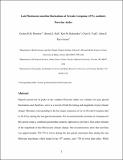| dc.contributor.author | Bromley, Gordon R. M. | |
| dc.contributor.author | Hall, Brenda L. | |
| dc.contributor.author | Rademaker, Kurt M. | |
| dc.contributor.author | Todd, Claire E. | |
| dc.contributor.author | Racovteanu, Adina E. | |
| dc.date.accessioned | 2019-01-10T14:58:23Z | |
| dc.date.available | 2019-01-10T14:58:23Z | |
| dc.date.issued | 2011-02-09 | |
| dc.identifier.citation | Bromley, Gordon R.M., Hall, Brenda L., Rademaker, Kurt M., Todd, Claire E., & Racovteanu, Adina E. (2011). Late Pleistocene snowline fluctuations at Nevado Coropuna (15°S), southern Peruvian Andes. Journal of Quaternary Science, 26(3), 305-317. doi: 10.1002/jqs.1455 | en_IE |
| dc.identifier.issn | 0267-8179 | |
| dc.identifier.issn | 1099-1417 | |
| dc.identifier.uri | http://hdl.handle.net/10379/14782 | |
| dc.description.abstract | Deposits preserved on peaks in the southern Peruvian Andes are evidence for past glacial fluctuations and, therefore, serve as a record of both the timing and magnitude of past climate change. Moraines corresponding to the last major expansion of ice on Nevado Coropuna date to 20-25 ka, during the last glacial maximum. We reconstructed the snowline at Coropuna for this period using a combined geomorphic-numeric approach to provide a first-order estimate of the magnitude of late-Pleistocene climate change. Our reconstructions show that snowline was approximately 550-770 m lower during the last glacial maximum than during the late Holocene maximum, which ended in the 19(th) century, and similar to 750 m lower than today. While these values are similar to data from nearby Nevado Solimana, reconstructions from the neighbouring peak of Nevado Firura reveal a smaller snowline depression, suggesting the glacial response to climate forcing in the tropics is strongly influenced by non-climatic factors. These data constitute some of the first directly dated palaeo-snowline data from the arid tropics and suggest that the magnitude of the last glaciation in at least parts of the tropical Andes was similar to late-Pleistocene events at higher latitudes. Copyright (c) 2011 John Wiley & Sons, Ltd. | en_IE |
| dc.description.sponsorship | Funding for the fieldwork was generously provided by the Dan and Betty Churchill Foundation, the Geological Society of America Graduate Student Research Grant programme, the Sigma Xi Grants‐in‐aid‐of‐research programme and the Comer Science and Educational Foundation. | en_IE |
| dc.format | application/pdf | en_IE |
| dc.language.iso | en | en_IE |
| dc.publisher | Wiley | en_IE |
| dc.relation.ispartof | Journal of Quaternary Science | en |
| dc.rights | Attribution-NonCommercial-NoDerivs 3.0 Ireland | |
| dc.rights.uri | https://creativecommons.org/licenses/by-nc-nd/3.0/ie/ | |
| dc.subject | LAST GLACIAL MAXIMUM | en_IE |
| dc.subject | EQUILIBRIUM-LINE ALTITUDES | en_IE |
| dc.subject | LATE QUATERNARY GLACIATION | en_IE |
| dc.subject | CLIMATE-CHANGE | en_IE |
| dc.subject | TROPICAL ANDES | en_IE |
| dc.subject | CORDILLERA BLANCA | en_IE |
| dc.subject | NEW-ZEALAND | en_IE |
| dc.subject | BOLIVIAN ALTIPLANO | en_IE |
| dc.subject | REGIONAL SYNTHESIS | en_IE |
| dc.subject | NORTHERN CHILE | en_IE |
| dc.title | Late Pleistocene snowline fluctuations at Nevado Coropuna (15 degrees S), southern Peruvian Andes | en_IE |
| dc.type | Article | en_IE |
| dc.date.updated | 2018-12-27T22:39:43Z | |
| dc.identifier.doi | 10.1002/jqs.1455 | |
| dc.local.publishedsource | https://doi.org/10.1002/jqs.1455 | en_IE |
| dc.description.peer-reviewed | peer-reviewed | |
| dc.internal.rssid | 13081944 | |
| dc.local.contact | Gordon Bromley, -. - Email: gordon.bromley@nuigalway.ie | |
| dc.local.copyrightchecked | Yes | |
| dc.local.version | ACCEPTED | |
| nui.item.downloads | 126 | |


